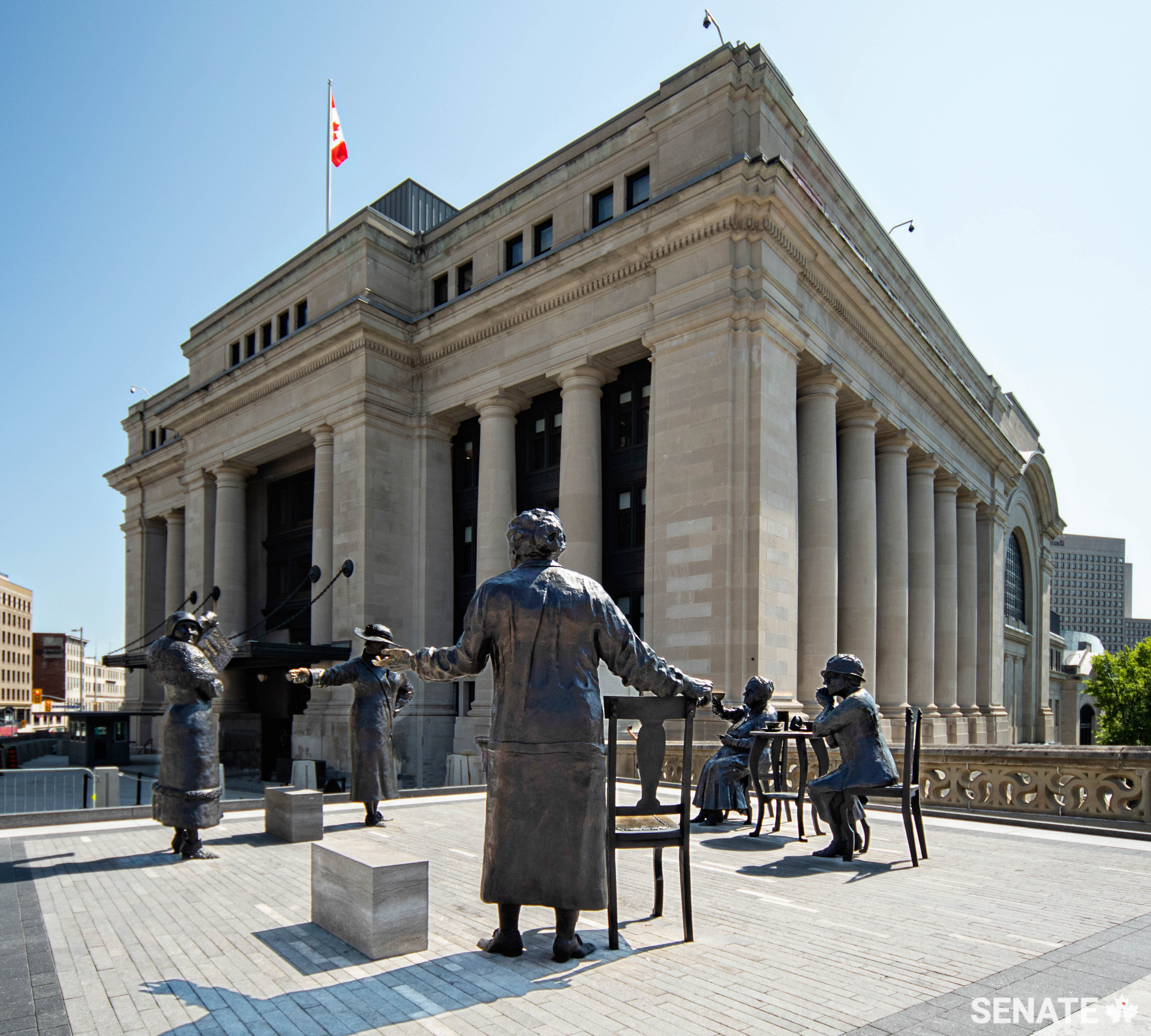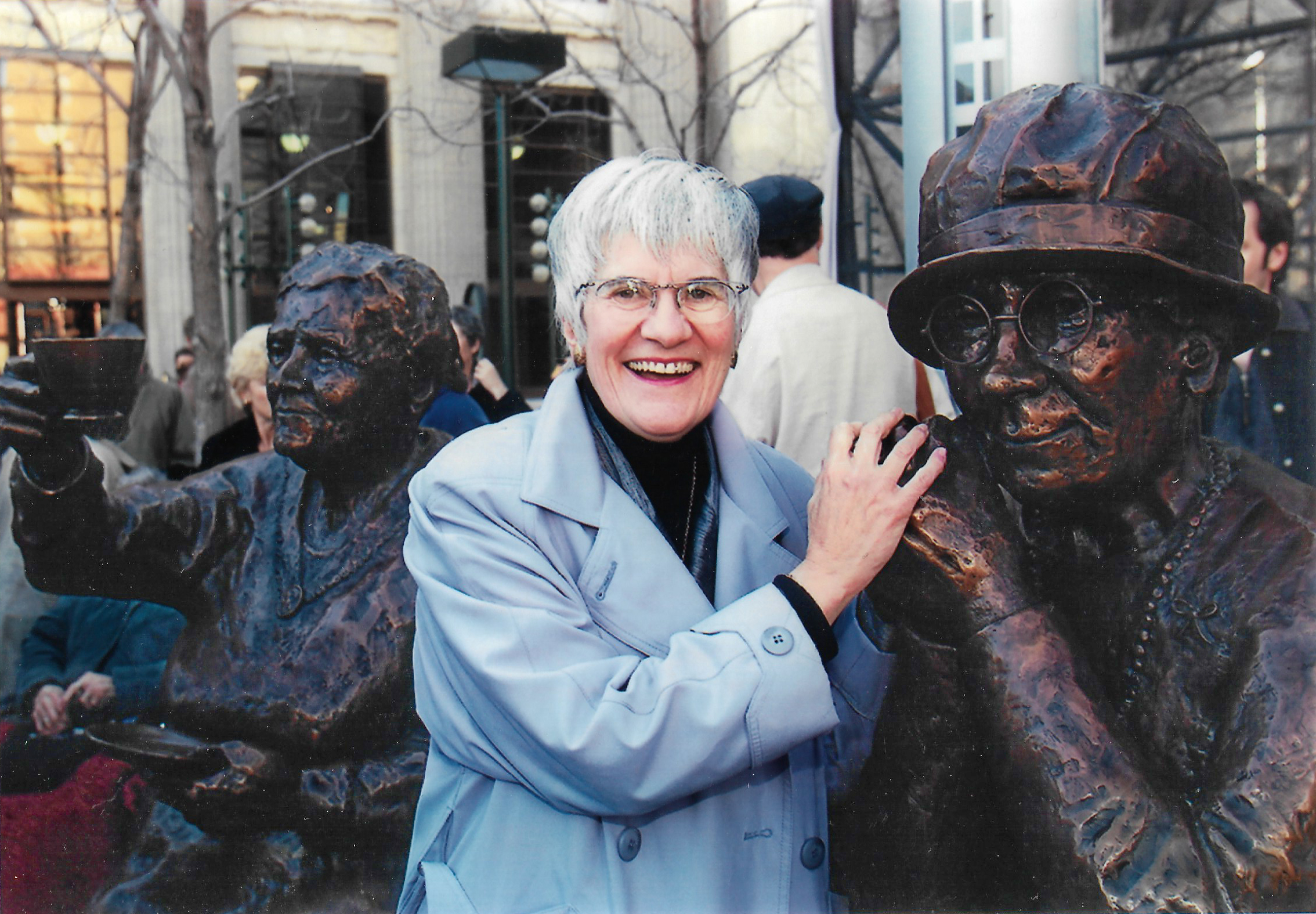EXCLUSIVE: Meet the sculptor who immortalized Canada’s Famous Five

Disclaimer: The Senate acknowledges that since the writing of this article, social awareness and perspectives on these individuals have evolved, particularly around issues of diversity and inclusion. The Senate acknowledges that these changes in context are important and encourages readers to consider the content in light of the ongoing discussions and evolving social understanding.
Anyone who has visited the Senate of Canada Building has likely made the acquaintance of the five women taking tea near its main entrance. The sculpture of Alberta’s Famous Five is popular with visitors to Ottawa, who often climb onto the empty chair and take selfies with the ladies.
“Including that chair was one of the best decisions I ever made,” said sculptor Barbara Paterson, who created the Women are Persons! monument. “I love to see that shiny patina on the seat and chair back.”
“Nothing pleases me more than to see signs that the sculpture has been touched and handled.”
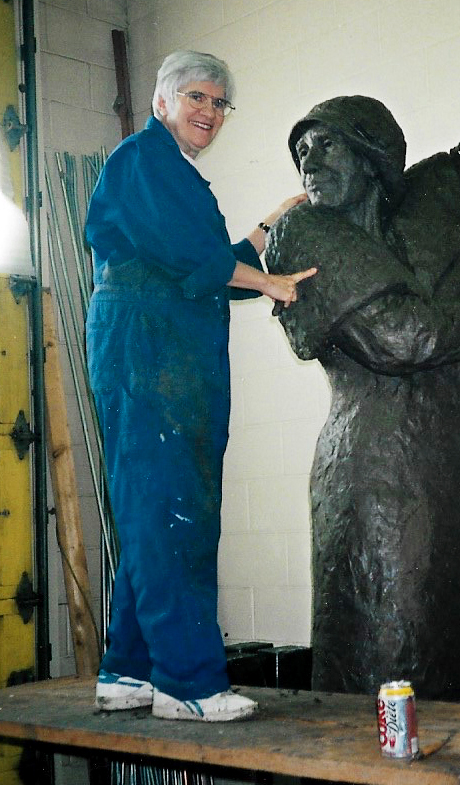
October 2020 marks 20 years since the Famous Five arrived in downtown Ottawa. Originally placed between Centre Block and East block, the monument moved from Parliament Hill in 2019 as the rehabilitation of Centre Block got underway, and was painstakingly reassembled beside the Senate of Canada Building.
“I was a little anxious when I heard it was moving,” Mrs. Paterson said in an exclusive interview with SenCAplus. “But if it has to be off the Hill for a few years, I’m glad it’s in a spot with lots of pedestrian traffic — it’s crucial that the statue meet people at eye level and draw them in to interact with it.”
Mrs. Paterson needn’t have worried. The statues and story of Emily Murphy, Nellie McClung, Louise McKinney, Irene Parlby and Henrietta Edwards continue to captivate Canadians who remember the heroes who fought for women to be recognized as persons.
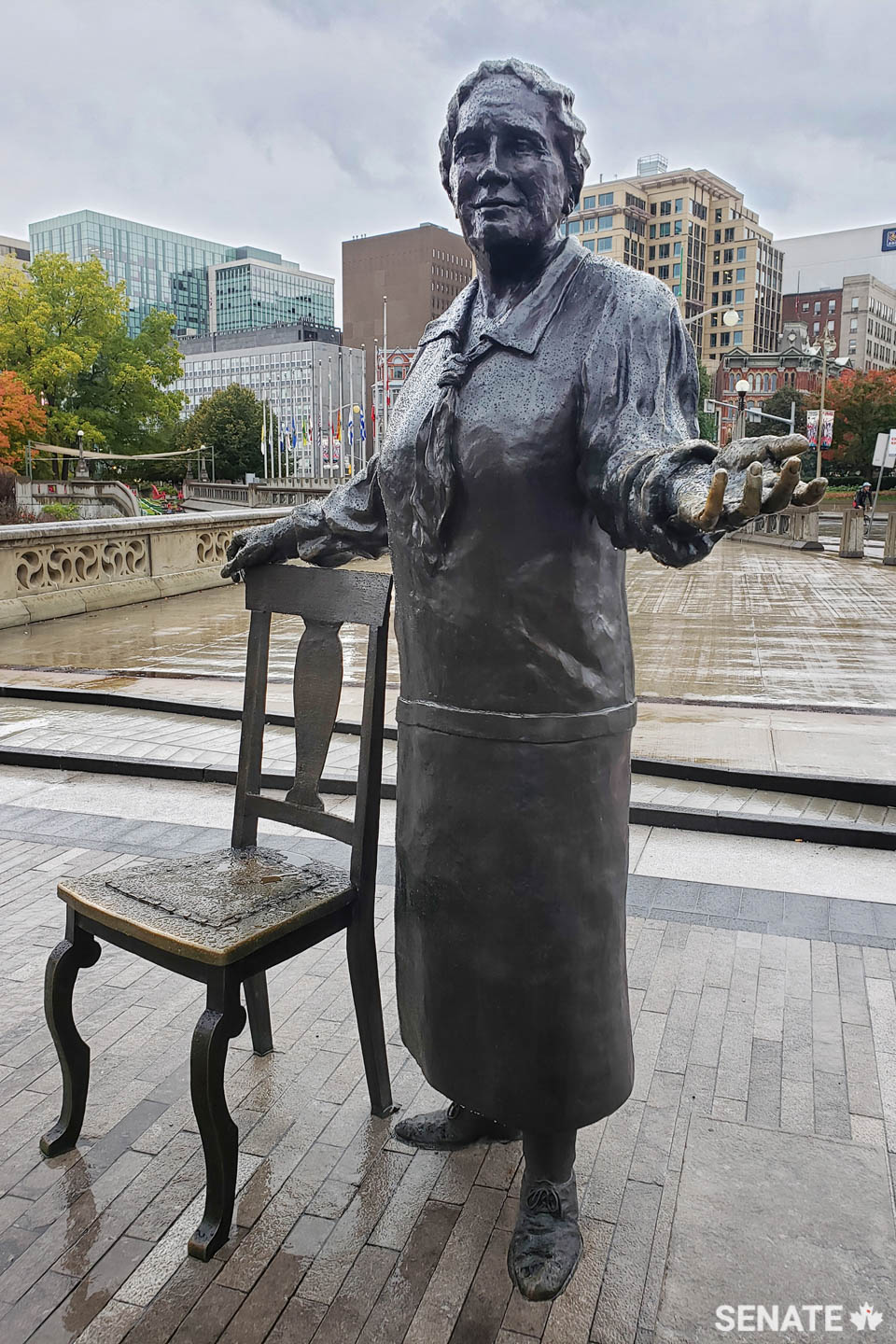
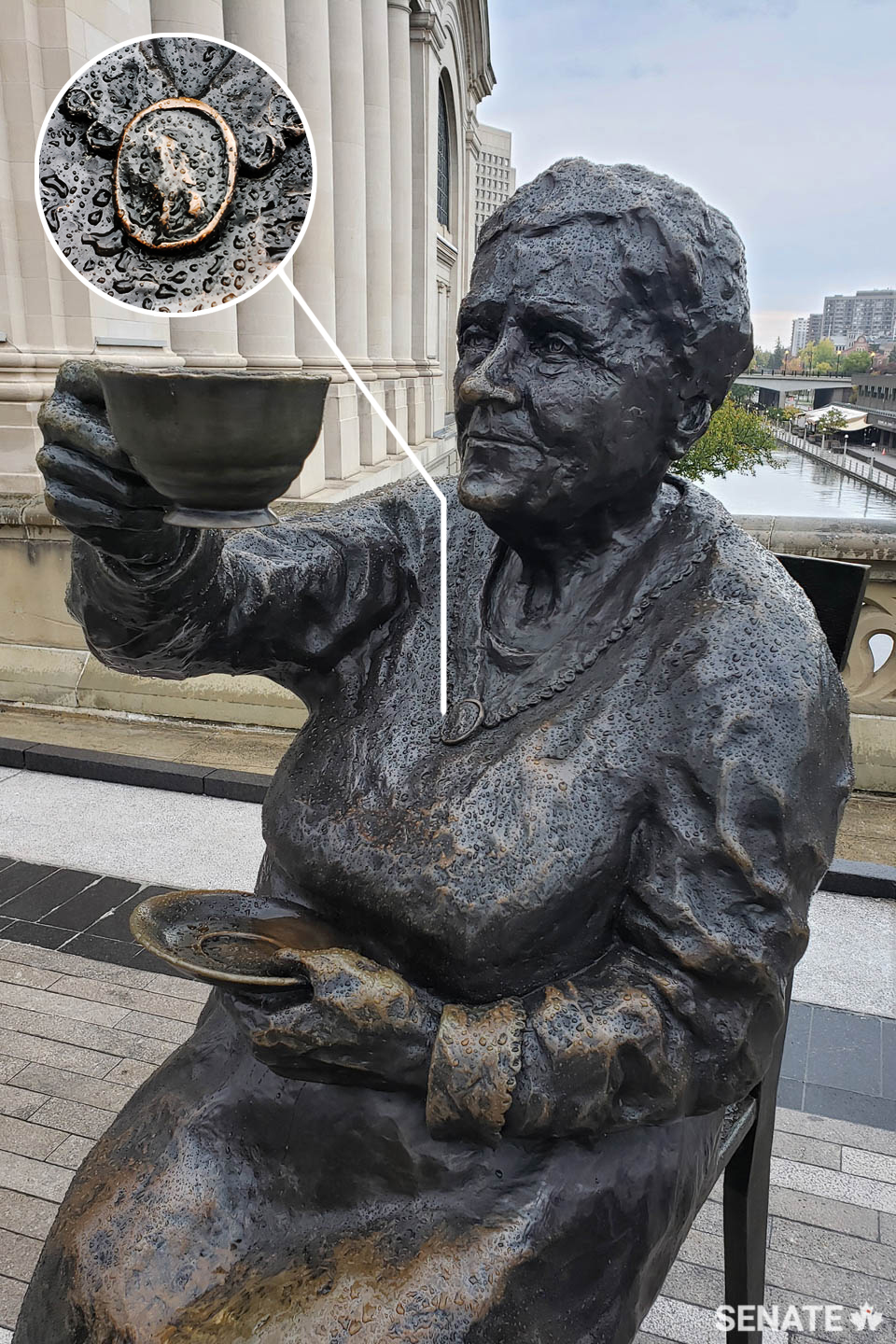
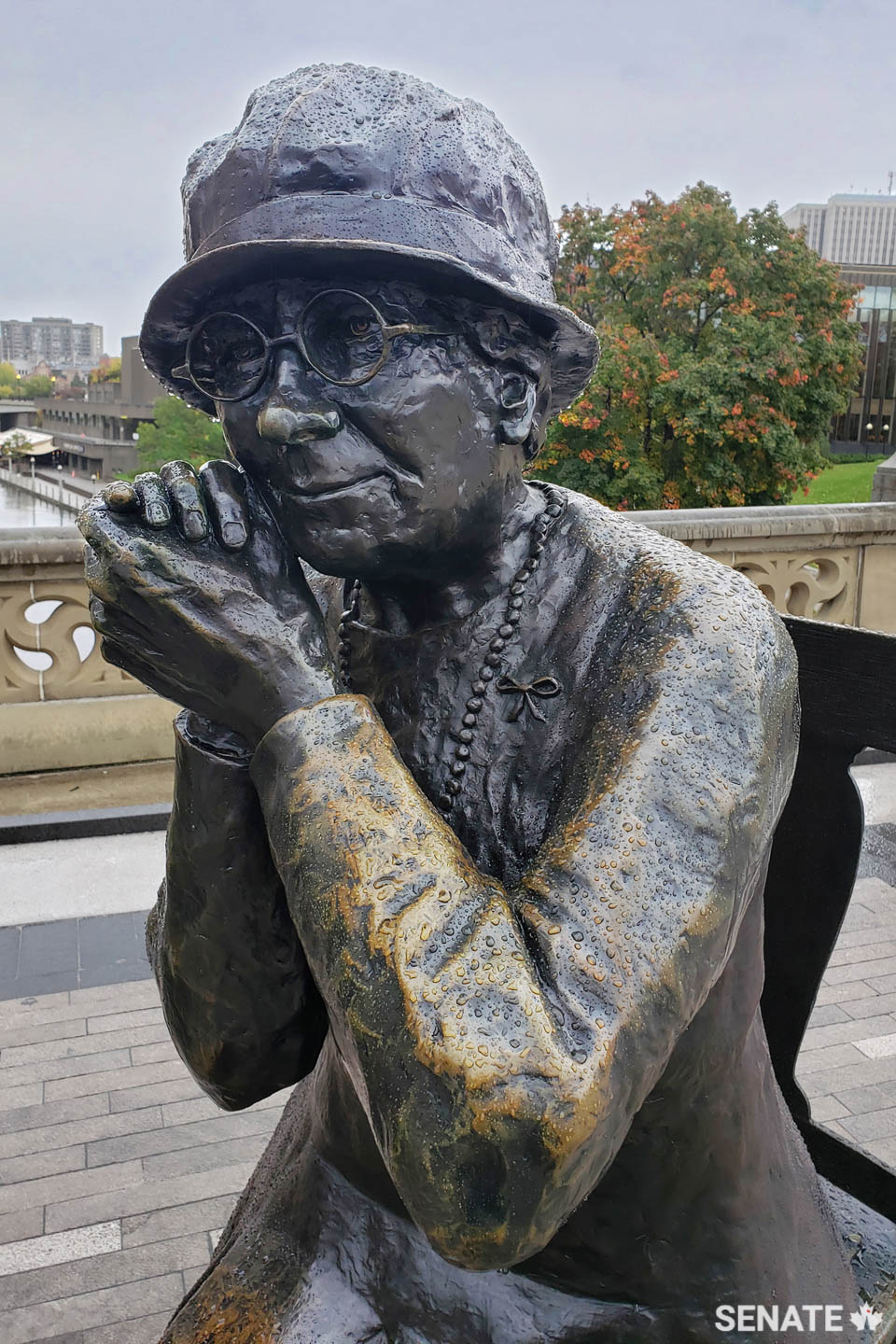
A monumental anniversary
October 18 is Persons Day, the anniversary of the Famous Five’s victory in what has come to be known as the Persons Case.
Having secured women the vote in Manitoba, Alberta and Saskatchewan, and having helped to open the judiciary and provincial legislatures to women, the Famous Five were already household names before they joined forces in 1927.
Frances Wright, co-founder of the Famous 5 Foundation that sponsored the monument in the 1990s, said they “braved new paths.”
“These women are Canada’s democratic champions,” she said.
“The Famous Five certainly inspired me,” said Mrs. Paterson. “It wasn’t just the example they set fighting for women’s rights in Canada. In terms of my career, everything changed for me after that commission.”
The five westerners had challenged the interpretation of a phrase in section 24 of the British North America Act, Canada’s founding constitutional document. The act said “qualified Persons” were to serve in the Senate; this was understood to refer exclusively to men. The Famous Five persuaded the Canadian government to ask the Supreme Court to clarify whether “persons” included women.
In April 1928, the five men on the Supreme Court took about 10,000 words to reach their conclusion: no. The act, they wrote, had to be interpreted in the context of the time it was written. In 1867, women could not vote, run for office or serve as elected officials and so they could not be “qualified Persons” under the act.
The women, incensed but galvanized, took their case across the ocean to Canada’s highest court of appeal at the time, the Judicial Committee of the Privy Council in London, England. On October 18, 1929, the British court overturned the Canadian court’s decision.
“The exclusion of women from all public offices is a relic of days more barbarous than ours,” it ruled. “To those who ask why the word should include females, the obvious answer is why should it not.”
The Calgary campaign
In 1996, the Famous 5 Foundation undertook to mark the 70th anniversary of that victory, approaching Calgary city council about erecting a monument in the city’s Olympic Plaza. The statue would be funded by five prominent Canadian women — among them Vivienne Poy, Canada’s first senator of Asian descent — each donating $200,000 toward the estimated $1-million cost.
The foundation invited 18 artists to submit proposals. Mrs. Paterson sketched a charmingly subversive scene of the five gathered for a celebratory tea. Nellie McClung brandishes a newspaper proclaiming “Women are Persons!” while the others toast the Privy Council ruling.
Three finalists went on display in the form of maquettes — clay miniatures of the proposed pieces — at Calgary’s Wallace Galleries. In the fall of 1997, the winner was announced; Mrs. Paterson’s piece had been the unanimous choice of both jury and public.
Mrs. Paterson was thrilled to win the commission but a little daunted.
“I thought, ‘What am I doing?’ I felt like I was biting off more than I could chew,” she said.
The sculptor made weekly trips from her Edmonton home to Calgary’s Bronzart Casting, where she completed the full-scale version, at one-and-a-quarter times life-size, in a concrete loading bay at the back of the foundry. She modelled over a rough skeleton constructed of plywood and molded foam, refining the details in a mixture of wax and clay.
“It was scorching in the summer and freezing in the winter,” Mrs. Paterson said. “The foundry had huge fans, like airplane propellers, working all the time. It was windy and very noisy, especially with all the foundry machines, heaters, grinders and welding equipment.”
Pitching to Parliament
While Calgary debated the proposal, the foundation approached Ottawa about installing a version next to Centre Block. If approved, it would be the first sculpture on Parliament Hill depicting identifiable women other than Queen Victoria and Queen Elizabeth II.
Senators were enthusiastic.
“These five women were nation builders and leaders who fought to strengthen democracy in Canada,” said Catherine Callbeck, one of dozens of senators who spoke in favour. “They should be recognized amongst other great leaders of our nation.”
The Senate voted unanimously to go ahead with the statue on December 18, 1997 — Henrietta Edward’s birthday. The Ottawa decision spurred Calgary to green-light its version, which was unveiled on October 18, 1999 and then reworked for the Ottawa installation exactly a year later.
For the Famous 5 Foundation’s Ms. Wright, the statues remain an essential part of the parliamentary landscape.
“Barbara has created an incredible monument, one which immediately connects with visitors. She brought the Famous Five to life and created one of the most-loved sculptures in Canada.”
Hidden surprises
While the subject matter is serious, Mrs. Paterson couldn’t resist adding a few surreptitious details, including a reproduction of her parents’ 1929 wedding announcement on the flip side of Nellie McClung’s newspaper and a portrait of the Paterson family’s terrier, Dickens, in Henrietta Edwards’ locket.
“Adding personal touches like these creates a comfort zone around the piece,” Mrs. Paterson said. “It makes the piece appear less lonely and unapproachable.”
In its new location by the Senate of Canada Building — right in the heart of downtown Ottawa on a busy street full of pedestrians — the monument gains new fans every day.
“My goal has always been to promote women through my art but also to depict them on an approachable, human scale. People seem to respond to that combination in the Famous Five sculpture – it seems to draw them in, make them want to interact with these women and connect with their story at a personal level.”
“Who knew these five figures of everyday Alberta women would have such an impact?”
